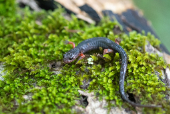Cheoah Bald Salamander (Plethodon cheoah)
Description: This species were formerly considered subspecies of the Jordanís salamander (Plethodon jordani). It has dark grey bodies with lighter grey cheek patches and are easily identified by their red legs. Some individuals may have brassy flecking on the back. Some ocoee salamanders (Desmognathus ocoee) may have red legs but will also have a light line from the eye to the back of the jaw. Unlike red-legged salamanders, the back legs of the ocoee salamander are also much stockier than the front legs.
Habitat: This species is found in mesic forest, often under leaf-litter, logs, or mossy rocks. It is a terrestrial breeder. Most of the species' range includes secondary growth forest, so it is thought to be somewhat tolerant of disturbance. It breeds by direct development, as with congeners.
Range: This species is known from Cheoah Bald, in Graham and Swain counties, North Carolina. It occurs at elevations between 975 to 1,524 meters above sea level.
Found in these States:
NC
Diet: probably consume a wide variety of small forest floor invertebrates.
Reproduction: It is likely that they lay their eggs in underground cavities. Females of most closely-related species will guard their eggs until hatching and it is thought that females of both of these species probably do the same. Hatchlings do not go through an aquatic larval stage. Instead, when young salamanders emerge from their eggs they look like miniature adults.
Status: Listed as Vulnerable since this species is only known from one threat-defined location. Ongoing deforestation in the surrounding area may lead to loss and fragmentation of suitable habitats and encroachment into the reserve in the future, which could drive the species to Critically Endangered in a very short time
»» Kingdom: Animalia - Animals
»» Phylum: Chordata - Chordates
»» Subphylum: Vertebrata - Vertebrates
»» Class: Amphibia - (Amphibians)
»» Order: Caudata - Salamanders
»» Family: Plethodontidae - Lungless Salamanders
»» Genus: Plethodon
»» Species: Plethodon cheoah - Cheoah Bald Salamander
This article uses material from the Wikipedia article "Cheoah Bald Salamander", which is released under the Creative Commons Attribution-Share-Alike License 3.0. Content may have been omitted from the original, but no content has been changed or extended.
|













